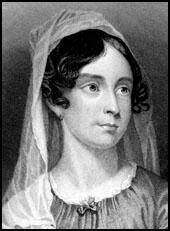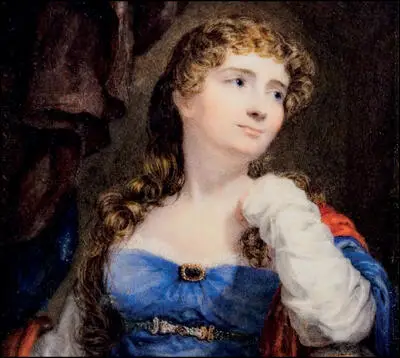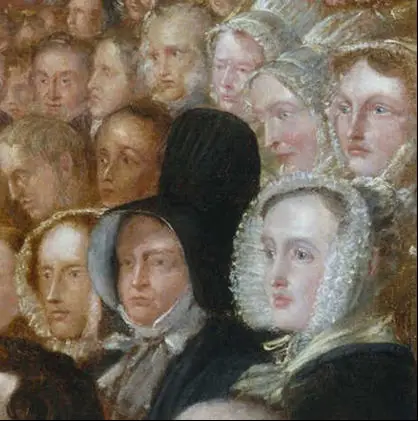Annabella Byron

Annabella Milbanke, the only child of Sir Ralph Milbanke and his wife, Judith Noel Milbanke, was born at Elemore Hall, Pittington, on 17th May 1792. Her father, the eldest son of Sir Ralph Milbanke of Halnaby Hall, was the Whig MP for County Durham and was renowned for his work for the poor and his support for the abolition of slavery.
According to Joan Pierson "Both parents were enlightened, and Annabella and her adopted sister, Sophie Curzon, were among the first to be inoculated. She was brought up to be concerned for the workers and tenants of the estate and helped establish a school in Seaham. An early reader, Annabella Milbanke was especially interested in mathematics and astronomy, which she studied with a Cambridge tutor; new ideas on magnetism and phrenology fascinated her." (1)
Annabella Milbanke met George Gordon Byron, sixth Lord Byron (1788–1824), in 1812. He considered her to be a "piquant, pretty and... a level-headed, unsophisticated country girl". (2) Lord Byron was a well-known figure who had scandalized London by starting an affair with Lady Caroline Lamb and was ostracized when he was suspected of having a sexual relationship with his half-sister, Augusta Leigh, who gave birth to an illegitimate daughter. (3)
Byron attending the House of Lords where he became a strong advocate of social reform. In 1811 he was one of the few men in Parliament to defend the actions of the Luddites and the following year spoke against the Frame Breaking Bill, by which the government intended to apply the death-penalty to Luddites. Byron's political views influenced the subject matter of his poems. (4)

Annabella rejected his first marriage proposal but accepted his second proposal in 1814 and they were married on 2nd January 1815. Their daughter, Ada, was born in December of that year. However Byron's continuing obsession with Augusta and his continuing sexual escapades with actresses and others, made their marital life difficult. Annabella considered Lord Byron insane, and in January 1816 she left him, taking their daughter, and began proceedings for a legal separation. A few months later he labeled his former wife a "moral Clytemnestra." (5)
Meanwhile, Lady Byron had returned to her early ambitions to help the poor and ignorant. A supporter of the Brighton Co-operative Society, she helped establish a branch in Hastings. She also lent the ground floor of her house in Brighton to the mechanics' institute for educational purposes. Lady Byron established the Ealing School that provided lessons in carpentry, masonry, and marketing gardening. (6)
Annabella was active in the anti-slavery movement and in June 1840 attended the World Anti-Slavery Convention held at Exeter Hall in London. However, as a woman was refused permission to speak. Anne Knight became aware that the artist, Benjamin Robert Haydon, had started a group portrait of those involved in the fight against slavery. She wrote a letter to Lucy Townsend complaining about the lack of women in the painting. "I am very anxious that the historical picture now in the hand of Haydon should not be performed without the chief lady of the history being there in justice to history and posterity the person who established (women's anti-slavery groups). You have as much right to be there as Thomas Clarkson himself, nay perhaps more, his achievement was in the slave trade; thine was slavery itself the pervading movement." (7)
When the painting was completed it did not include Lucy Townsend or most of the leading female campaigners against slavery. Clare Midgley, the author of Women Against Slavery (1995) points out that as well as Anne Knight and Lucretia Mott, it does feature Lady Byron, Elizabeth Pease, Mary Anne Rawson and Amelia Opie: "Haydon's group portrait is exceptional in that it does record the existence of women campaigners. Most other memorials did not. There are no public monuments to women activists to complement those to William Wilberforce, Thomas Clarkson and other male leaders of the movement... In the written memoirs of these men, women tend to appear as helpful and inspirational wives, mothers and daughters rather than as activists in their own right." (8)

showing from left to right, bottom row: Annabella Byron, Amelia Opie,
Mary Anne Rawson, top row, Anne Knight, Mrs John Beaumont and Elizabeth Pease.
Lady Byron became involved in improving slum conditions and discussing rights for women. She worked with Mary Carpenter, the pioneer worker in reformatories for girls. She argued passionately that society should undertake the education and care of orphans. Lady Byron also started a vocational school at Ockham in Surrey. (9)
In 1850, two escaped slaves, Ellen Craft and William Craft came to England. Along with William Wells Brown they spoke at several meetings on the subject of slavery. Harriet Martineau arranged for the Crafts to spent two years at Ockham School where they were taught to read and write. They were offered positions as superintendent and matron of the industrial department but decided instead to open a lodging house in London. (10).
Lady Byron died on 16th May 1860.
Primary Sources
(1) Daisy Hay, New York Times (4th December, 2015)
Annabella Milbanke has historically gotten bad press. During their uneasy courtship, her future husband, Lord Byron, christened her the “princess of parallelograms”: a backhanded accolade to bestow on even the most mathematically inclined 19th-century bride. By September 1816, a few months after the end of their short and disastrous marriage, he had labeled his wife a “moral Clytemnestra.”
Following Byron’s death, his biographer Thomas Moore wrote dismissively that while Annabella might have made an ordinary man happy, she was entirely unsuited to be the companion of a man of genius. When Annabella herself died, her own biographer and champion, Harriet Beecher Stowe, unwittingly did further damage to Annabella’s reputation by asserting - correctly - that Byron had had an incestuous relationship with his half sister: a revelation designed to present Annabella as the maligned victim of an immoral man, but which succeeded only in miring her name in scandal once again. Although recent commentators on the Romantics have written about her with more understanding, the charge sheet against Annabella remains lengthy. She is routinely accused of denying her dying daughter pain relief on the grounds of her Christian convictions, of hounding her defenseless sister-in-law and of demonstrating ridiculous naïveté in thinking she could make Byron happy in the first place.
Julia Markus’s new biography of Annabella sets out to redress the imbalance. Lady Byron and Her Daughters places Annabella at the center of a group of women whose lives were shaped in profound ways by Byron, a group that encompasses his half sister and mistress, Augusta; his illegitimate daughter Medora; and Annabella’s own daughter, Ada Lovelace, an extraordinary pioneer of computer programming. The stories of these women weave in and out of Annabella’s history, demonstrating both her capacity for doing good and the extent to which her uncompromising self-righteousness damaged those around her.
Markus, a novelist and biographer, is by no means blind to the qualities in Annabella that made her difficult to like. She is, however, determined to recount the Byrons’ marriage from Annabella’s perspective: “The time has come to realize that history is also her story.” The result is biography-as-vindication, the version of the genre in which the biographer occupies the role of defense counsel as well as chronicler. Annabella’s misjudgments are contextualized and explained away while her charitable work and maternal devotion are highlighted. In this account, Byron is an abuser before he is a poet, and Markus is stringent in her criticism of literary scholars who have allowed the brilliance of his pen to blind them to his personal faults.
Lady Byron and Her Daughters therefore offers an important corrective to the notion that Annabella was, in Markus’s words, “the demented and dull-witted demon” depicted by 20th-century critics. Here Annabella is not merely an unsatisfactory bit player in Byron’s glamorous tragedy but a person in her own right, a woman of intelligence and imagination who made something of her life in the most difficult of circumstances. The result is feminist biography in the best sense, a recalibration of literary history through which silenced female voices are heard.
Markus is a skilled and sure-footed storyteller who sketches in the complications of Byron’s biography with speed and assurance, letting the details of Annabella’s lesser-known after-life as a philanthropist and single parent take center stage. A narrative style peppered with interjections such as "Reader, prepare for a train wreck" will not be to everyone’s taste, but it has the effect of keeping the pace up even when historical circumstance threatens to slow things down. Similarly, not all readers will agree with the occasionally unnuanced assessments of Byron and Annabella. Beyond doubt, however, is the importance of a book that celebrates “a worthy but complex woman who led a big life that is still unsung.” Long may such singing as this continue.

